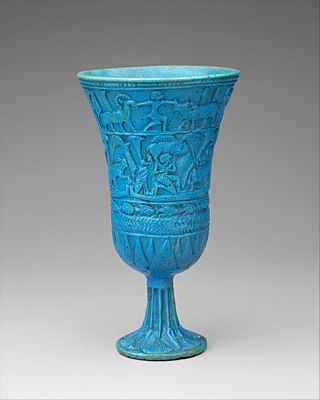
Bes, together with his feminine counterpart Beset, is an ancient Egyptian deity worshipped as a protector of households and, in particular, of mothers, children, and childbirth. Bes later came to be regarded as the defender of everything good and the enemy of all that is bad. According to Donald Mackenzie in 1907, Bes may have been a Middle Kingdom import from Nubia or Somalia, and his cult did not become widespread until the beginning of the New Kingdom, but more recently several Bes-like figurines have been found in deposits from the Naqada period of pre-dynastic Egypt, like the thirteen figurines found at Tell el-Farkha

A statue is a free-standing sculpture in which the realistic, full-length figures of persons or animals are carved or cast in a durable material such as wood, metal or stone. Typical statues are life-sized or close to life-size; a sculpture that represents persons or animals in full figure but that is small enough to lift and carry is a statuette or figurine, whilst one more than twice life-size is a colossal statue.

The Middle Kingdom of Egypt is the period in the history of ancient Egypt following a period of political division known as the First Intermediate Period. The Middle Kingdom lasted from approximately 2040 to 1782 BC, stretching from the reunification of Egypt under the reign of Mentuhotep II in the Eleventh Dynasty to the end of the Twelfth Dynasty. The kings of the Eleventh Dynasty ruled from Thebes and the kings of the Twelfth Dynasty ruled from el-Lisht.

Ancient art refers to the many types of art produced by the advanced cultures of ancient societies with different forms of writing, such as those of ancient China, India, Mesopotamia, Persia, Palestine, Egypt, Greece, and Rome. The art of pre-literate societies is normally referred to as prehistoric art and is not covered here. Although some pre-Columbian cultures developed writing during the centuries before the arrival of Europeans, on grounds of dating these are covered at pre-Columbian art and articles such as Maya art, Aztec art, and Olmec art.

Faience or faïence is the general English language term for fine tin-glazed pottery. The invention of a white pottery glaze suitable for painted decoration, by the addition of an oxide of tin to the slip of a lead glaze, was a major advance in the history of pottery. The invention seems to have been made in Iran or the Middle East before the ninth century. A kiln capable of producing temperatures exceeding 1,000 °C (1,830 °F) was required to achieve this result, the result of millennia of refined pottery-making traditions. The term is now used for a wide variety of pottery from several parts of the world, including many types of European painted wares, often produced as cheaper versions of porcelain styles.

The ushabti was a funerary figurine used in ancient Egyptian funerary practices. The Egyptological term is derived from 𓅱𓈙𓃀𓏏𓏭𓀾 wšbtj, which replaced earlier 𓆷𓍯𓃀𓏏𓏭𓀾 šwbtj, perhaps the nisba of 𓈙𓍯𓃀𓆭 šwꜣb "Persea tree".

Ancient Egyptian art refers to art produced in ancient Egypt between the 6th millennium BC and the 4th century AD, spanning from Prehistoric Egypt until the Christianization of Roman Egypt. It includes paintings, sculptures, drawings on papyrus, faience, jewelry, ivories, architecture, and other art media. It was a conservative tradition whose style changed very little over time. Much of the surviving examples comes from tombs and monuments, giving insight into the ancient Egyptian afterlife beliefs.

Amenemhat I, also known as Amenemhet I, was a pharaoh of ancient Egypt and the first king of the Twelfth Dynasty of the Middle Kingdom.
Lisht or el-Lisht is an Egyptian village located south of Cairo. It is the site of Middle Kingdom royal and elite burials, including two pyramids built by Amenemhat I and Senusret I. The two main pyramids were surrounded by smaller pyramids of members of the royal family, and many mastaba tombs of high officials and their family members. They were constructed throughout the Twelfth and Thirteenth Dynasties. The site is also known for the tomb of Senebtisi, found undisturbed and from which a set of jewelry has been recovered. The pyramid complex of Senusret I is the best preserved from this period. The coffins in the tomb of Sesenebnef present the earliest versions of the Book of the Dead.

Egyptian blue, also known as calcium copper silicate (CaCuSi4O10 or CaOCuO(SiO2)4 (calcium copper tetrasilicate)) or cuprorivaite, is a pigment that was used in ancient Egypt for thousands of years. It is considered to be the first synthetic pigment. It was known to the Romans by the name caeruleum. After the Roman era, Egyptian blue fell from use and, thereafter, the manner of its creation was forgotten. In modern times, scientists have been able to analyze its chemistry and reconstruct how to make it.

Egyptian faience is a sintered-quartz ceramic material from Ancient Egypt. The sintering process "covered [the material] with a true vitreous coating" as the quartz underwent vitrification, creating a bright lustre of various colours "usually in a transparent blue or green isotropic glass". Its name in the Ancient Egyptian language was tjehenet, and modern archeological terms for it include sintered quartz, glazed frit, and glazed composition. Tjehenet is distinct from the crystalline pigment Egyptian blue, for which it has sometimes incorrectly been used as a synonym.

Two Minoan snake goddess figurines were excavated in 1903 in the Minoan palace at Knossos in the Greek island of Crete. The decades-long excavation programme led by the English archaeologist Arthur Evans greatly expanded knowledge and awareness of the Bronze Age Minoan civilization, but Evans has subsequently been criticised for overstatements and excessively speculative ideas, both in terms of his "restoration" of specific objects, including the most famous of these figures, and the ideas about the Minoans he drew from the archaeology. The figures are now on display at the Heraklion Archaeological Museum (AMH).

A frit is a ceramic composition that has been fused, quenched, and granulated. Frits form an important part of the batches used in compounding enamels and ceramic glazes; the purpose of this pre-fusion is to render any soluble and/or toxic components insoluble by causing them to combine with silica and other added oxides. However, not all glass that is fused and quenched in water is frit, as this method of cooling down very hot glass is also widely used in glass manufacture.

Pottery was produced in enormous quantities in ancient Rome, mostly for utilitarian purposes. Some of this pottery has been uncovered into the 21st century in the former territory of the Roman Empire, as well as in other parts of the world, especially in waste mounds such as Monte Testaccio.
Reading Egyptian Art: A Hieroglyphic Guide to Ancient Egyptian Painting and Sculpture is a 1992 primer on Egyptian hieroglyphs written by English archaeologist Richard H. Wilkinson.The book was written from the viewpoint of seeing hieroglyphs in the context of their use in iconography of sculpture, monuments, reliefs, tomb reliefs, literature, specifically the corpus of The Book of the Dead versions for various deceased Egyptians, and other areas.

The Department of Egyptian Antiquities of the Louvre is a department of the Louvre that is responsible for artifacts from the Nile civilizations which date from 4,000 BC to the 4th century. The collection, comprising over 50,000 pieces, is among the world's largest, overviews Egyptian life spanning Ancient Egypt, the Middle Kingdom, the New Kingdom, Coptic art, and the Roman, Ptolemaic, and Byzantine periods.

Ceramic art is art made from ceramic materials, including clay. It may take varied forms, including artistic pottery, including tableware, tiles, figurines and other sculpture. As one of the plastic arts, ceramic art is a visual art. While some ceramics are considered fine art, such as pottery or sculpture, most are considered to be decorative, industrial or applied art objects. Ceramic art can be created by one person or by a group, in a pottery or a ceramic factory with a group designing and manufacturing the artware.

The Metropolitan Museum of Art has a number of blue faience vases and chalices from Ancient Egypt in its collection. The vessels, which range in condition from full works to fragments, are dated to the Third Intermediate Period of Egypt.
Ancient Cypriot art refers to all works of visual art originating from Cyprus in the Eastern Mediterranean from c. 10,000 BC to c. 330 AD. During this period, various types of objects were produced such as domestic tools, weaponry, jewellery, and decorative figurines. This range of art attests to the blend of both native and foreign influences of ancient Egypt, Greece and Rome as they successively occupied the country. Artworks produced in ancient Cyprus incorporate almost all of the mediums of visual art worked on in ancient history including terracotta, stone, metals, glass, and gemstones.

The Statuette of the lady Tiye is a wooden statue of a high-status woman from the reign of Amenhotep III to Akhenaten ; Dynasty 18 of the New Kingdom of ancient Egypt. Believed to depict a leading servant of the powerful Great Royal Wife Tiye, her title has been variously translated over the years as "Chief of Weavers" / "Chief of the Household" / "mistress of the harim". It is one of only about 160 wooden statues discovered from the New Kingdom. It currently resides in the Metropolitan Museum of Art.




















